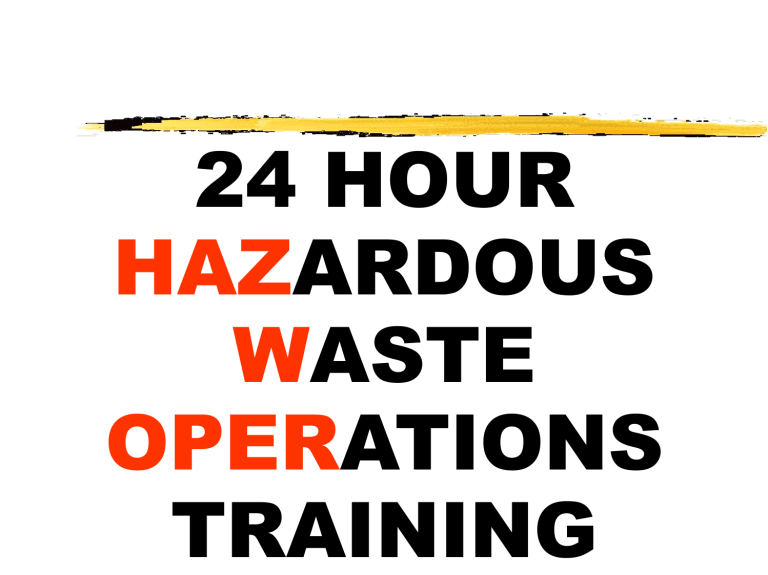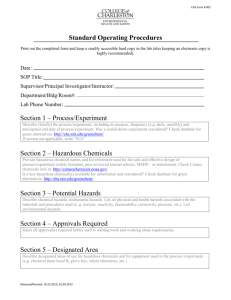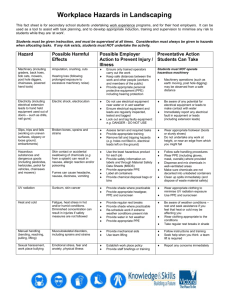16 HOUR SUPPLEMENTAL HAZARDOUS WASTE SAFETY AND

24 HOUR
HAZ
ARDOUS
W
ASTE
OPER
ATIONS
TRAINING
Agenda
Day One
Regulations
Engineering Controls
Hazard Recognition
Chemical Toxicology
Biological and
Radiological Toxicology
Personal Protective
Equipment
Day Two
Medical Surveillance
Monitoring and
Sampling
Decontamination
Safe Work Practices
Confined Space
Handling drums and other containers
Transportation of
Hazardous Wastes
Emergency Procedures
Agenda
Day Three
Decontamination
Review
Tabletop
Identification and
Hazard
Assessment
Tabletop
Drill/Exercise
Written Test
Introduction
What is HAZWOPER?
Hazardous Waste Sites
Treatment, Storage and Disposal Sites
Emergency Response regardless of location
OSHA/EPA
Colorado Department of Public Health and the Environment.
Introduction
Training Requirements
40 Hours off-site + 3 day on- site
Who? Why?
24 Hours off-site + 1 day on- site
Who? Why?
8 Hour Supervisor
Who? Why?
Environmental Laws
CERCLA
RCRA
SARA
TSCA
40
CERCLA
Comprehensive Environmental Response
Compensation Liability Act
Commonly referred to as the the Superfund law, requires cleanup of releases of hazardous substances in the air, water, groundwater, and on the land.
Both new spills and leaking or abandoned dumpsites are covered.
RCRA
Resource Conservation and Recovery Act
Effective October 21,1976, with three distinct goals.
To protect human health and the environment
To reduce waste and conserve energy and natural resources
To reduce or eliminate the generation of hazardous waste as efficiently and quickly as possible
Governs wastes from “cradle to grave”
SARA
Superfund Amendments and
Reauthorization Act
Effective 1986, Gave more authority to the
EPA and reauthorized funding
Mandated OSHA to develop health and safety standards for hazardous waste workers. (HAZWOPER regulations)
SARA Title III - Community Right to Know
TSCA
Toxic Substance Control Act
Sets standards for the manufacturing, handling and use of toxic chemicals.
Requires employees to be trained on the hazards associated with handling and use of toxic chemicals.
OSHA
REGULATIONS
Occupational Safety and Health ACT
Effective April 28, 1971
Requires:
All workers have a safe and healthy work environment.
All employers to take steps to protect employees from recognized hazards or eliminate such hazards.
Provides employee rights and responsibilities.
Rights &
Responsibilities
Rights
To a safe work place
To request an inspection
To request information on safety and health hazards in the work place
To exercise your rights without discrimination
Responsibilities
Comply with all OSHA
Standards
Follow all safety rules and wear appropriate PPE
Report hazardous conditions to your supervisor
Report any illness or injury promptly
OSHA
• Four Categories of Standards
Design Standards
Performance Standards
Vertical Standards
Horizontal Standards
• 29 CFR 1910.120 paragraphs
(b) through (o)
OSHA Regulations
29 CFR 1910
29 CFR 1926
Ventilation
Noise
Ionizing Radiation
Hazardous Materials
PPE
Fire Protection
Material Handling
Electrical
Trenching
29 CFR 1910.120
Hazardous Waste Sites
Superfund Sites
Corrective action/Clean up at RCRA Sites
Voluntary Clean up recognized by
Governmental agencies
Treatment, Storage and Disposal Sites
Emergency Response
HAZWOP ER Standard
Scope, Application and Definitions
Safety and Health
Program
Site Characterization
Site Control
Training
Medical Surveillance
Engineering Controls
Monitoring
Informational
Programs
Handling Drums and
Containers
Decontamination
Emergency
Response
Illumination
Sanitation
New Technology
Safety & Health Program
Organizational Structure
Comprehensive Work plan
Site-Specific Health and Safety Plans (HASP)
Health and Safety Training Program
Medical Surveillance Program
Standard Operating Procedures
Coordination/Interface Procedures
Site-Specific Plan
Key Personnel
Health and Safety
Risk Analysis
Site Control
Measures
Training Assignments
Medical Surveillance
Requirements
Personal Protective
Equipment
Air and Employee
Monitoring
Spill Containment
Confined Space
Procedures
Decontamination
Procedures
Emergency Response
Plan
SITE
CHARACTERIZATION
Requirements
Found in Paragraph (c)
Topics
Preliminary evaluation
Hazard identification
Required information
Personal protective equipment
Monitoring
Risk identification
Employee notification
OFF - SITE
CHARACTERIZATION
Performed prior to entry
Divided in two parts:
- Interview/Records
Search
- Perimeter
Reconnaissance
ON - SITE
CHARACTERIZATION
Purpose is to verify and supplement information obtained from off-site survey.
ON - SITE
CHARACTERIZATION
Types of Containers
Labels or Markings
Condition of
Containers
Condition of Materials
Identify Wind
Shadows
Determine Potential
Pathways of
Dispersion
Indicators of exposure
Safety Hazards
Identify Reactive,
Flammable or
Corrosive Materials
Collect Samples
Note Land Features
Note Natural irritants
Poison Ivy
Site Control
Work Zones
Worker Safety
Procedures
Site Map The Site Control
Program
Buddy System
Communications
Network
Nearby Medical
Facilities
Site Map
Compile a site map prior to entry and update throughout course of operation. Denote changes, evacuation routes, problems areas, wind shadows, etc.
Work Zones
Site Security
During
Working Hours
And
Off-duty Hours
Communication
Internal
Radios
Noisemakers
Bells
Sirens
Visual Signals
Hand Signals
Lights
Flags
Flares
External
Off-Site
Emergency
Response
Site Management
Regulatory Agencies
Buddy System
Provide Partner with
Assistance
Observe Partner for signs of Chemical or
Heat Exposure
Periodically Check
Integrity of Partners PPE
Notify Site Manager if
Emergency Assistance is
Needed
Site Preparation
This can be as hazardous as site cleanup
Some major steps that need to be implemented
- Roadways
- Traffic Flow
- Building Construction
- Work Zone
Safe Work Procedures
SAFE WORK
PROCEDURES
• Confined Space
Procedure
• Personal Protective
Equipment
• Lock Out-Tag Out
Procedures
Engineering
Controls
Safe Work
Procedures
Standing Orders
Medical Facilities
Nearest Medical
Facilities
Ambulances
Hospitals
Emergency Clinics
Police
Fire
Map
Risks And Hazards
Hazardous materials present three main risks:
Health
Fire
Reactivity
Health
Health hazards are dependent on the materials involved and the routes of entry.
Inhalation
Ingestion
Absorption
Skin Contact
Fire
Fires can develop as a result of leaks or spills.
Liquids or vapors that readily ignite can cause burns and other heat related injuries
Reactivity
Some chemicals will react when place in contact with others.
Reactions can vary from generation of toxic gases to polymerization to violent explosions.
Due to the threat of explosions, reactivity is the most feared.
Identification And
Hazard Assessment
Assessment
The MOST critical aspect of a hazardous substance response is the identification of the substances and a thorough assessment of the hazards that are presented.
You can’t manage the site/incident if you can’t identify and assess the problem.
Identification
Information Sources:
M.S.D.S.
Placards and Labels
Shipping Papers
Reference Guides
Technical Information Centers
NFPA 704 System
Computer Data Bases
Other (Monitoring results, witnesses, process knowledge, etc.)
Assessment
This process is the basis for the selection of
PPE, control measures, engineering controls, monitoring devices, decontamination methods, disposal and everything associated with this incident/site.
At least three sources are preferred to perform an identification and hazard assessment.
Key Acronyms
BP=Boiling point
FP=Flash point
IT=Ignition temperature
FR=Flammable range
LFL(LEL) and UFL(UEL)=Upper and Lower
Flammable (Explosive) limits
SG=Specific Gravity
VD=Vapor Density
VP=Vapor Pressure
Sol=Solubility
Chemical Toxicology
Toxicology
the degree to which a chemical or substance has a harmful effect on humans or other living things.
Based on information gained from:
Epidemiological studies
Animal Studies
Chemical Toxicology
Routes of Entry
Inhalation
Ingestion
Injection
Contact
Chemical Toxicology
Dose
It is the dose that kills not the material.
Water is toxic at a certain dose as well as table salt.
Synergistic Effects
Asbestos &
Smoking
LD50 and LC50
The amount of material that results in the deaths of 50% of a sample group of laboratory animals
Radiological Toxicology
Ionizing
Alpha
Beta
Gamma
Neutron
Non-ionizing
Radiant heat
Lasers
Ultraviolet light
Radio waves
Radiological Toxicology
Alpha
Largest particle
Stopped by paper/clothing
Health hazard if inhaled or ingested
Only travel a few centimeters in the air.
Beta
Smaller particles and they travel further
Stopped by thin metal, a thickness of wood, plastic or glass.
Health hazard to the skin, eyes and internal organs if ingested or inhaled
Radiological Toxicology
Gamma
Most dangerous
NO mass, just pure energy
Travel great distances
Will pass through the human body and interact with living cells
Stopped by lead, concrete, and other dense materials
Radiological Toxicology
Measuring/Monitoring
RAD - radiation absorbed dose
REM - roentgen equivalent man
mrad/hr, rad/hr or mrem/hr, rem/hr
What measuring devices do you have?
Protection
Time
Distance
Shielding
As Low As
Reasonably
Achievable (ALARA)
Toxicology
Acute vs. Chronic
Kind of material, concentration, and physical state
Type of toxin
Dose
Duration of exposure
Frequency of exposure
Personal tolerances (dose/response)
Target Organs of toxin
Personal Protective
Equipment (PPE)
Written PPE Program
Number of personhours that workers will wear various PPE
Levels of exposure
Adequacy of the PPE
Operational
Guidelines
Training and Fitting
Procedures
Decon, cleaning, inspection, maintenance and storage procedures
Accident and Illness experience
Selection Procedures
Respiratory Equipment
Air purifying respirators
Air supplying respirators
Supplied Air
Respirator(SAR)
Self-contained
Breathing
Apparatus(SCBA)
Air Supplying Respirators
SCBA
Positive or Negative Pressure
Open Circuit
Time limitations
Closed Circuit
Weight
SAR
Positive Pressure
Escape SCBA
Air line length
300 feet
Air Purifying Respirators
Powered Air-Purifying
Respirator
Positive Pressure
Full Face/Half Face
Respirator
Negative Pressure
Particulate Filter
Sorbent
Cartridges/Canisters
Combination
PPE Selection
Based on Hazard assessment.
Compatible with exposure.
Sufficient durability.
Temperature effects.
Decon Methods
Permeation
Chemical/material moves through protective clothing.
Degradation
Loss of or change in the fabric’s chemical resistance.
Penetration
Movement of contaminates through zippers, seams, tears, etc.
EMERGENCY SITUATIONS
Emergency alarm signals
Puncture wounds, scrapes or abrasions
Halon discharge
Sickness
Air supply disruption
Level A PPE
Highest Protection Provided for:
• Respiratory Tract
• Skin
• Eyes
Level A Equipment
Recommended:
• SCBA or SAR
• Totally Encapsulating
Chem.Resistant Suit
• Chem. Resistant Inner
&Outer Gloves & Boots
Optional:
• Cooling Unit
• Coveralls
• Hard Hat
• Disposable Gloves
• Boot Covers
Level B PPE
• Maximum Respiratory
Protection
• Lesser Degree of Skin
Protection
• Minimal Level
Recommended for
Initial Site Entry Until
Hazards Are Identified
Level B Equipment
RECOMMENDED:
• SCBA or Supplied-Air
Respirator with Escape SCBA
• Chem. Resistant Clothing
• Chem.Resistant Inner and Outer
Gloves & Boots
OPTIONAL:
• Hard Hat
• Coveralls
• Face shield
• Disposable Gloves
• Boot Covers
• Long Cotton Underwear
Level C PPE
Same skin protection as
Level B PPE
Lesser degree of respiratory protection, the contaminates are known.
Air Purifying Respirators
(APR’s) with compatible cartridges.
Level C PPE
RECOMMENDED:
• Air Purifying Respirator (APR)
• Chem. Resistant Clothing
• Chem.Resistant Inner and Outer Gloves & Boots
OPTIONAL:
• Hard Hat
• Coveralls
• Face shield
• Disposable Gloves
• Boot Covers
• Long Cotton Underwear
Level D PPE
Minimal Skin Protection
No Respiratory Protection
Normal work clothes, fire fighting turnout gear are level D
Level D PPE
RECOMMENDED:
• Hard Hat
• Coveralls
• Safety Glasses
• Safety shoes
OPTIONAL:
• Hearing protection
• Face shield
• Disposable Gloves
• Boot Covers
• Long Cotton Underwear
Limitations
Each level of PPE has limitations.
Visibility
Mobility
Heat Stress
Protection
All PPE must be compatible with the substance that you are working with, based on hazard assessment.
Medical Surveillance
Protection of Employee’s Health
Detecting pre-existing disease or medical conditions that may place an employee performing certain tasks in risk.
Minimizing individual exposures at the workplace, so that the disease process is never initiated.
Medical Surveillance
Site Medical Program
Components
Surveillance
Treatment
Record keeping
Program review
Medical Surveillance
Pre-employment screenings
Periodic medical exams
Follow up exams
After injury or overexposure
Exam after notifying employer of symptoms which may be related to exposure.
Termination exam
Medical Surveillance
Affected
Employees
Employees who are, or may be exposed to
PELs of hazardous substances or health hazards for 30 days or more per year
Employees who wear a respirator for 30 days or more per year
Members of organized
HAZMAT teams
Employees who are injured as a result of overexposure during a site emergency or who show symptoms of illness that may have resulted from overexposure to hazardous substances.
Monitoring & Sampling
Hazardous
Atmospheres
Explosive
Toxic
Oxygen deficient
Oxygen enriched
Radioactive
Monitoring & Sampling
Identify and quantify airborne contaminants on and off site.
Track changes in air contaminants that occur over the lifetime of the incident.
Assist in defining work zones
Ensure proper selection of work practices and engineering controls.
Determine the level of worker protection needed
Identify additional medical monitoring needs
Monitoring & Sampling
Direct Reading
Instruments
Multi-gas detectors
Dose-rate meters
Colormetric tubes
PID
Laboratory
Analysis
Gas sampling bags
Filters
Sorbents
Wet collection methods
Monitoring & Sampling
Perimeter monitoring
Zone requirements
Periodic monitoring
Work in a different area
Different operations, i.e. demolition vs. collection
Different contaminants
Obvious liquid contamination, spills or lagoons
Personal Monitoring
High risk employees
Area samples
Industrial hygiene techniques
Medical surveillance requirements
Illumination
FOOT
CANDLES
5
3
5
10
30
AREA OR
OPERATIONS
General Site
Excavation, Storage
Warehouses, Tunnels
General Shops
Offices
Sanitation
Potable Water
Nonpotable Water
Toilet facilities
Food handling
Washing facilities
Shower and change rooms
Safe Work Practices
Confined Space Procedures
Control of hazardous energy (Lock out)
Fall Protection
Material/Waste Handling
Confined Space
Limited entry and exit
Large enough and so configured to allow a person to enter and perform work
Not design for continuous human occupancy
Confined Space
“Permit Required ”
Contains or has the potential to contain a hazardous atmosphere
Potential for engulfment
Inwardly converging walls
Any other recognized serious safety or health hazard.
Confined Space
Training
Requirements
Entrant
Attendant
Supervisor
Rescue Team
Permit Requirements
Define the work
Evaluate all hazards
Monitoring requirements
Protection from all hazards
Names and number of entrants
ETC.
Material Handling
Hazards
• Detonation
• Fires
• Explosions
• Vapor Generation
• Physical Injury
Drum Handling
• 29 CFR 1910 and 1926 contain OSHA standards for chemical containers and their handling.
• 40 CFR 265 contains EPA requirements for waste containers and storage areas.
• 49 CFR 171-178 (DOT) specifies container standards and shipping procedures for hazardous wastes.
Drum Inspection
Monitor conditions in the immediate vicinity of drums.
Perform visual inspection of drums.
Classify drums into preliminary hazard categories.
Drum Inspection
Look for:
• Symbols, words, marks indicating contents.
• Signs of deterioration.
• Signs that the drum is under pressure.
• Drum type.
• Configuration of drum head.
Handling
The purpose of handling is to:
Respond to any obvious safety problems
Unstack and orient drums for sampling
Organize drums into different areas
Planning
A preliminary plan should contain:
• Extent of handling necessary
• Personnel selected for the job
• Appropriate procedures based on the hazards associated with the probable drum contents
Types Of Containers
Radioactive Waste
Explosive or Shock
Sensitive
Waste
Bulging Drums
Lab Pack Drums
Leaking, Open and
Deteriorated Drums
Buried Drums
Decontamination
Purpose Of Decon
• Cleans PPE & equipment
• Protects workers
• Prevents further contamination
• Protects environment
• Protects community
Zones
Ou ter Glo ve
Remov al
6
Bo ot Cov er
Remov al
5
9
Canister or
Mas k
Ch an ge
7 Su it/Safety Boo t Wash
8 Su it/Bo ot/Glo ve Rin se
10 Safety Bo ot Remo val
11 SCBA Backpack Remo val
12 Sp las h Suit Removal
13 Inner Glo ve Wash
14 Inner Glo ve Rin se
15 Face Piece Remov al
16 Inner Glo ve Remo val
17 Inner Clo th ing Remo val
EXCLUSION ZONE
Tape
Remov al
4
Bo ot Cov er &
Glov e Rin se
3
Bo ot Cov er &
Glov e Was h
2
HOTLINE
Segreg ated
Eq uipment Drop
1
MAXIMUM
DECONTAMINATION
LAYOUT
Level B Protection
CONTAMINATION REDUCTION ZONE
CONTAMINATION
CONTROL LINE
Field Wash 18 19 Redres s
SUPPORT ZONE
Decon Methods
Physical
Chemical
Combination
Health And Safety
Decontamination methods may:
Be incompatible with hazardous substances.
Be incompatible with equipment.
Pose a direct health hazard to workers.
Decon Equipment
Generally selected based on availability
• Tanks
• Brushes
• Buckets
• Storage Containers
Spill Response
Assume that
ALL SPILLED MATERIALS
ARE DANGEROUS
Fighting A Spill
Chemical Inactivation and
Absorption
Tabletop Drill
Drums
Storm Drain
Map
ABANDONED
VEHICLE



